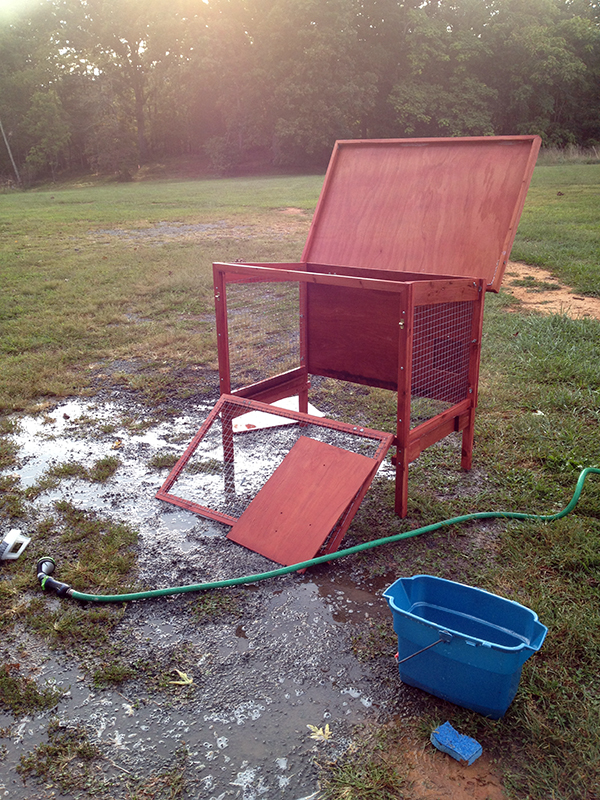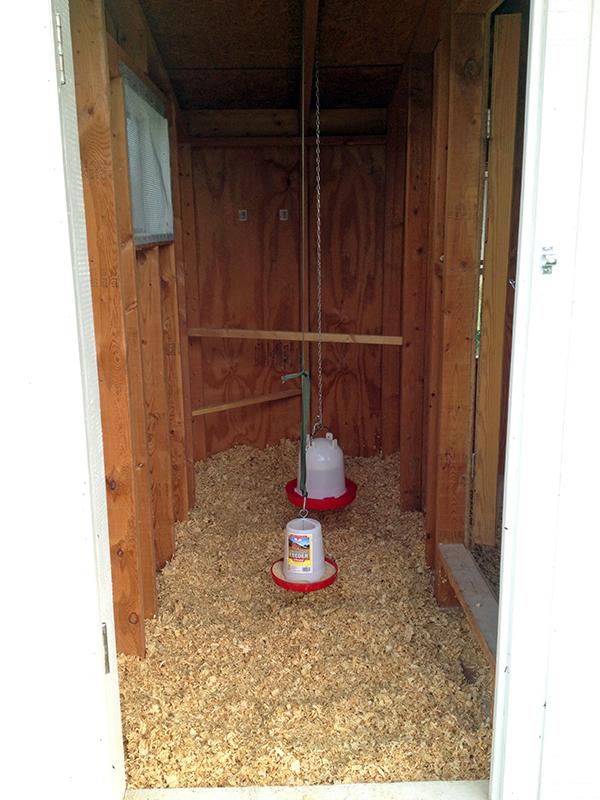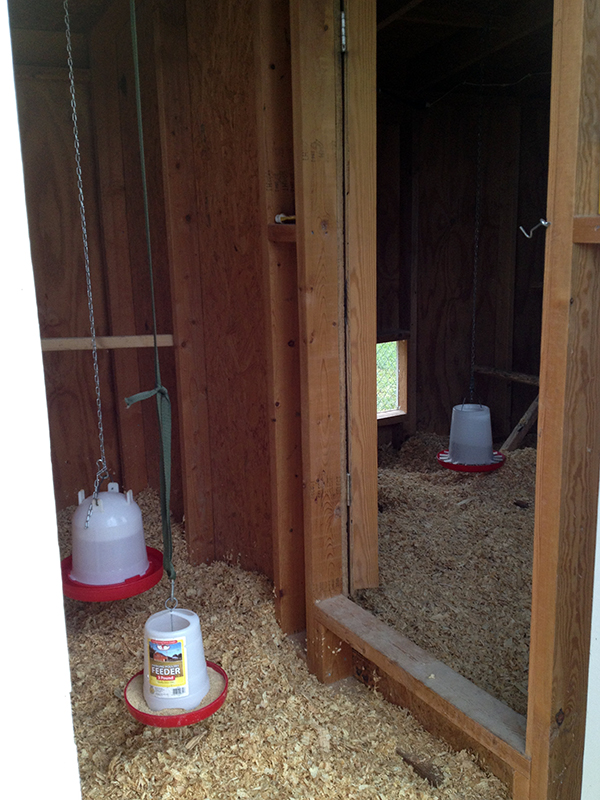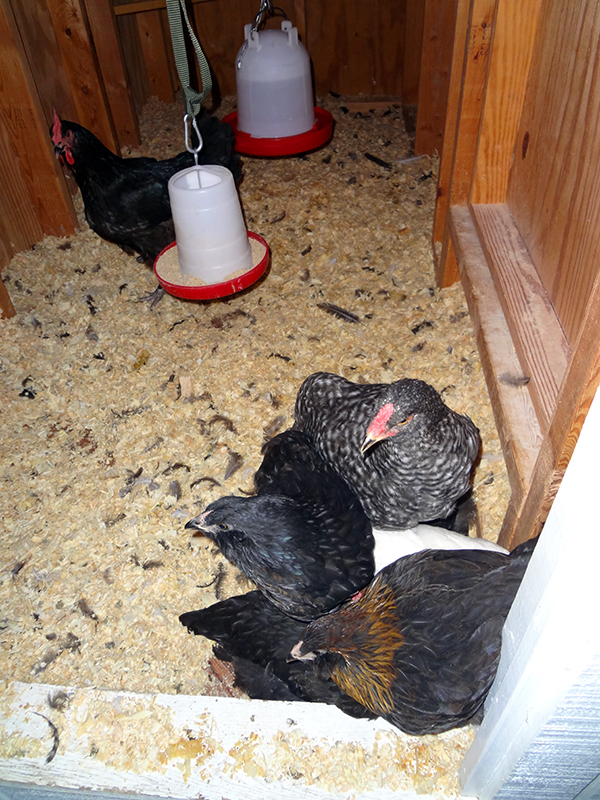Last weekend I cleaned out the chicken coop, a fairly onerous task that involves a tractor, snow shovel, air compressor, dust mask and goggles. Combine all those in your head with copious amounts of airborne chicken shit dust and pine shavings and you don’t need to see any photos.
The only reward for this task, other than the agrarian nerd pleasure I take in making a hefty deposit at the compost bank, is that once the coop has aired out for a day I get to fill it will two bales of clean pine shavings, scrub out the nest box, and return the bleached feeder and waterer to their chains, full of food, and well, water. It gives me no end of pleasure to make a beautiful, clean, and healthy home for all the creatures in my care. It’s something I remember from being a kid and having all sorts of pets that needed tending. It sure wasn’t pleasant to muck out the mouse cage, or the bird cage, or the fish tank. But once it was done the joy of seeing my animals in a fresh, clean home made all that dabbling in feces and urine pretty much worth it.
And today, I feel the same way. So I cleaned out the coop, and while I was at it I decided I was tired of the growing mess that was the broody coop in the garage. The six chicks were now chickens, and they made enough mess that the tray under their coop needed emptying every three days. And, in typical messy, wasteful chicken fashion, they’d spill their food out of the feeder, and it would fall under the screen only to incubate maggots. One day when I changed the pan it was so hot I couldn’t hold my hand to it—fermentation in action! Gross, right? So while the chicks were out ranging I broke down their coop and dragged it to the driveway, where I scrubbed it with hot water and bleach. And then I cleaned out my garage, vacuuming out feather dust and sweeping away spilled food and feathers.
These ready-made coops were some of the best purchases I’ve ever made. They were picked up by my dad, out of desperation, for $99 each on sale at Tractor Supply, on the day the guinea babies hatched and started running out of the dog crate in which they’d been born. It seemed like an awful amount of money at the time, but they’ve paid for themselves in the use I’ve gotten out of them. I’ve used these small coops for injured birds, to separate fighting hens, for broody coops, and to raise chicks. The materials and construction are pretty cheap, and I can’t imagine them as full-time homes for any animals, but they are great for the short periods in which I tend to use them. The design is good, and I really recommend them.
Once the broody coop was drying in the sun, I set up the “annex” of the big coop to house the chicks. This is the area you first enter when you open the coop, and where I normally store the chicken food and various supplies. It has only one window, so it gets much hotter in the summer than the larger part of the coop, which has two big windows for good airflow. But now that the temperature has dropped it would be fine for the chicks.
I spread pine shavings on the floor, nailed in a few roosts, and nailed up some chains to hold the feeder and waterer. Then it was all ready for the babies. Here you can see how the annex relates to the main coop. I figure it can’t hurt to have the older chickens getting used to the sounds of the chicks before I try to house them all together. It may stave off another bloody battle.
In their new home, the chicks were pretty unsure the first night. They kept trying to go back in the garage, where they’d been born. But I scooped them up and dumped them in their new home. Now, a few days later, they’ve figured out where the food is and are returning to the coop on their own in the evening. But there’s one problem: They don’t know how to roost.
I figure that because there wasn’t a roost in their broody coop, where they lived with their mother, they never got this important chicken lesson. For the last few nights I’ve checked on them in the night, and they’re sleeping like a pile of puppies, on the ground wedged in a corner. It’s kind of adorable except that it’s really not in a chicken’s nature to sleep in a pile past the young weeks of chickdom.
So just for an experiment, tonight I caught Dahlia and put her in with her babies. That’s her above, looking at her kids like, WTF, who are you? Then, like a proper chicken she jumped on the roost to sleep. I am hoping that she will have a talk with her children and teach them how to roost. I am not super concerned—after all, chicks that aren’t raised with broody hens eventually figure out how to roost. I am more curious than anything to see if Dahlia’s behavior can influence her chicks at such a late stage in their development.
Speaking of development, this morning I awoke to Calabrese crowing, followed by his young son Griz crowing in response. This went on for a while, back and forth. I am sure my neighbors love me!





[...] chicks learned how to roost from their mother last night! Here they are tonight around sundown, after a long day of free [...]